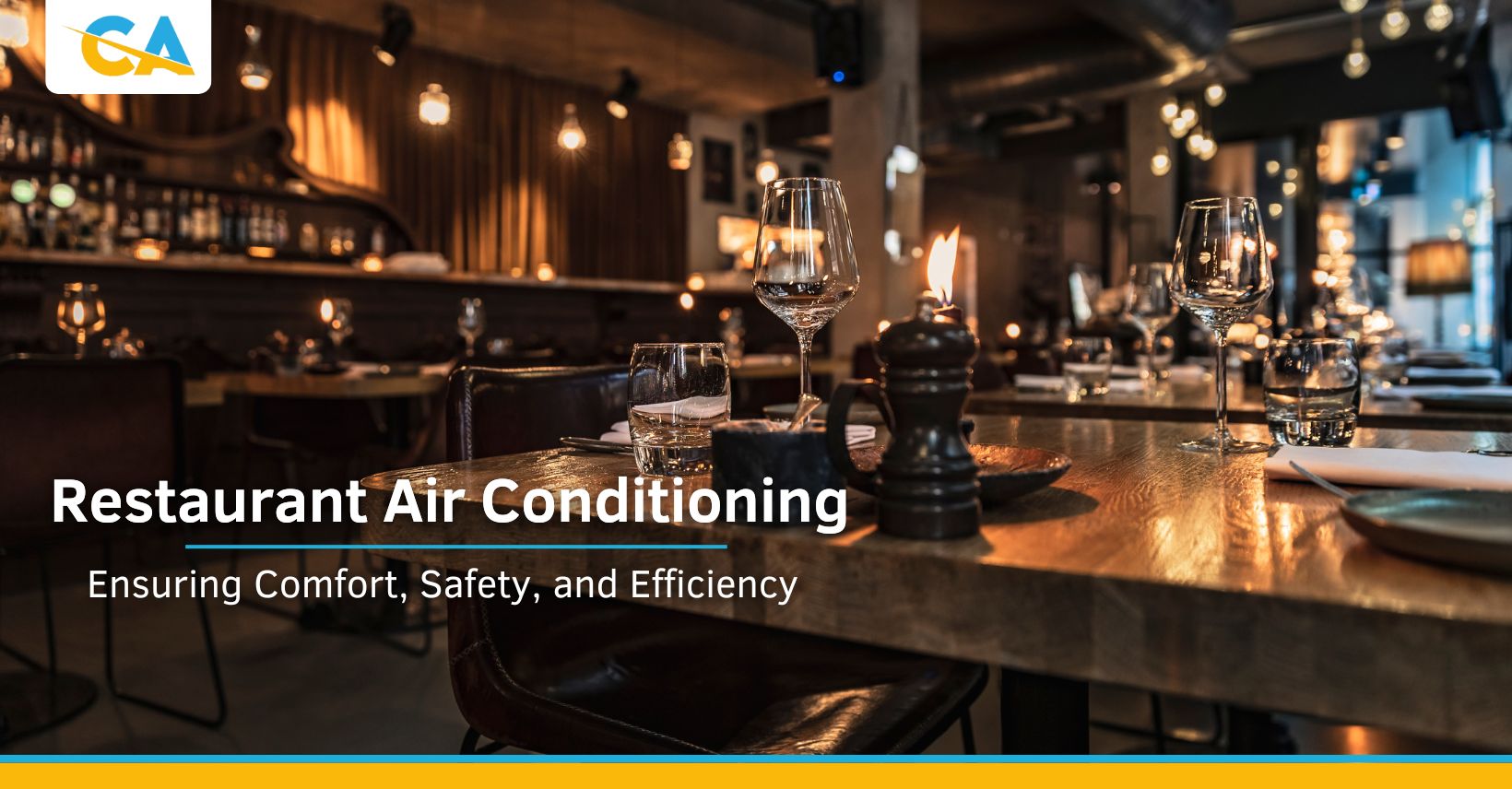When dining out, the experience is not just about the food and service – the atmosphere also plays a vital role.
Restaurant air conditioning is key to creating a comfortable and enjoyable environment for customers and food preservation.
In this article, we will explore the importance of air conditioning in restaurants, the ideal temperatures for different aspects of the dining experience, factors to consider when setting the temperature, how restaurant owners can ensure proper air conditioning, and the consequences of improper air conditioning.
Discover the key considerations for optimal restaurant air conditioning.
What Is Restaurant Air Conditioning?
Restaurant air conditioning uses commercial air conditioner units and cooling systems to regulate temperature and airflow, ensuring customer and staff comfort.
Wall-mounted units are favoured for their easy installation and space-saving design. In contrast, ceiling cassette units provide efficiency and even cooling.
These systems maintain an optimal indoor climate, control humidity, and ensure proper ventilation. Effective air conditioning improves customer experience and creates a better working environment for staff, supporting the restaurant’s success. With these benefits in mind, it’s clear why maintaining a comfortable atmosphere is important for dining establishments.
Why Is Air Conditioning Important in Restaurants?
Air conditioning in a restaurant enhances the customer experience by providing a comfortable dining environment. It supports the efficient operation of the kitchen by regulating temperature and airflow.
Proper air conditioning allows customers to dine without the discomfort of excessive heat or humidity, leading to longer stays, higher satisfaction, and more return visits.
In the kitchen, a well-cooled environment helps staff maintain food quality and prepare dishes efficiently. With adequate cooling, restaurants can avoid compromised food safety due to poor temperature control, discomfort among diners, and decreased staff productivity in a hot kitchen. Finding the right balance in temperature settings can make all the difference in creating an ideal atmosphere for diners and staff.
What Are the Ideal Temperatures for Restaurant Air Conditioning?
The ideal temperatures for restaurant air conditioning vary based on the specific areas within the restaurant, balancing ambient temperature for customer comfort, optimal conditions for food preservation, and safe storage practices.
Comfortable Temperature for Customers
Maintaining a comfortable temperature for customers is essential for enhancing their dining experience. The ambient temperature should be ideally set between 20°C and 22°C.
Temperature and humidity levels in the establishment influence customers’ comfort. High humidity can make the air feel heavier and less pleasant, affecting their overall experience.
This is where efficient climate control systems play a vital role. These systems regulate the temperature and help control humidity levels, ensuring a balanced environment that is conducive to customers’ relaxation and enjoyment.
Optimal Temperature for Food Preservation
The optimal temperature for food preservation is critical. To ensure food safety and quality, precise temperature control within the kitchen and storage areas is typically required.
Depending on the type of food, specific temperature ranges must be adhered to to prevent spoilage and maintain freshness. For example, perishable items like dairy products and meats require refrigeration temperatures between 0 °C and four °C.
Frozen foods should be kept at -18°C or below to prevent bacteria growth. Cooling systems such as fridges, freezers, and walk-in cold rooms play a vital role in achieving these conditions by creating the ideal environment for different food categories.
Safe Temperature for Food Storage
Food storage safety requires refrigeration units and HVAC systems to keep perishable items below 40°F. Proper HVAC system upkeep is essential for controlling the temperature in storage areas and preventing spoilage or bacterial growth.
Regular monitoring and calibration of refrigeration thermometers ensure accurate and consistent temperature readings, safeguarding the quality of stored food.
Similarly, managing ambient conditions in a restaurant is important for comfort and efficiency. Factors such as customer comfort, energy costs, and equipment performance all play a role in finding the right balance.
What Are the Factors to Consider When Setting the Temperature for Restaurant Air Conditioning?
When setting the temperature for restaurant air conditioning, several critical factors need to be considered, including the type of restaurant, its location and climate, and customer preferences, to ensure an optimal balance of comfort and efficiency.
Type of Restaurant
The type of restaurant, whether a fine-dining establishment or a fast-food outlet, greatly influences the choice of air conditioning system and temperature settings to meet specific requirements.
- Maintaining a controlled and comfortable ambiance for upmarket fine dining restaurants enhances the overall dining experience. These establishments often opt for central air conditioning systems that offer precise temperature control and even distribution.
- On the other hand, fast-food outlets, with their quick turnover and high traffic, require efficient cooling solutions to keep the kitchen and dining areas cool. They may rely on commercial-grade air conditioning units that can handle higher temperatures and constant foot traffic without compromising comfort.
Location and Climate
A restaurant’s location and prevailing climate conditions are vital in determining the necessary air conditioning settings to ensure a comfortable and consistent indoor environment.
For instance, in regions with extreme heat, such as desert areas, the air conditioning system must work harder to combat the high temperatures outside. This may require lower temperature settings and increased airflow to maintain a pleasant atmosphere indoors.
Customer Preferences
Customer preferences for ambient temperature vary widely, so restaurants must gather feedback and adjust air conditioning settings to maximise comfort and satisfaction.
Finding the ideal temperature isn’t just about comfort; it impacts the dining experience. Restaurants can request feedback through comment cards, online surveys, or direct interactions to gain insights into preferred temperature levels.
After collecting feedback, analysing the data and making informed thermostat adjustments are essential. Regular temperature checks and a comfortable atmosphere boost customer loyalty and generate positive reviews.
Considering these factors, it becomes important to understand the steps restaurant owners can take to ensure proper air conditioning and maintain an inviting environment.
How Can Restaurant Owners Ensure Proper Air Conditioning?
Restaurant owners can ensure proper air conditioning by implementing regular maintenance schedules, conducting inspections, using properly sized and placed air conditioning units, and adopting energy-efficient systems.
Regular Maintenance and Inspections
Regular AC unit maintenance and inspections are required to ensure efficient operation and longevity, prevent unexpected breakdowns, and prevent costly repairs.
One of the first steps in ensuring the optimal performance of your AC unit is to clean or replace the air filters regularly. Clogged filters can obstruct airflow, reducing the system’s efficiency. Also, check for leaks or blockages in the ductwork and ensure that the thermostat is functioning correctly.
Scheduled inspections by a professional technician can detect potential issues early, preventing major malfunctions. Professional service includes lubricating moving parts, checking refrigerant levels, and assessing overall system performance.
Properly Sized and Placed Air Conditioning Units
Using properly sized and strategically placed AC units ensures efficient cooling and optimal airflow throughout the restaurant, enhancing energy efficiency and comfort.
When determining the size of the restaurant’s AC units, it is important to consider the establishment’s square footage. Larger establishments will require more powerful units to adequately cool the space, while smaller restaurants may suffice with smaller units.
The placement of the units plays a vital role in their effectiveness. Placing the units in central locations can help distribute cool air evenly, reducing the workload on the units and lowering energy costs.
Use of Energy-Efficient Systems
Incorporating energy-efficient systems and leveraging advanced HVAC technology can reduce energy consumption and operational costs while maintaining optimal restaurant climate control.
These systems significantly drop utility bills, benefiting the restaurant’s bottom line and contributing to environmental sustainability by lowering the carbon footprint.
Designed for efficiency, they enhance performance and longevity, requiring less maintenance and repairs, which translates to additional cost savings.
A more comfortable dining environment for customers also boosts loyalty and positive reviews. However, when air conditioning isn’t managed properly, it can lead to several unexpected issues impacting the business and its patrons.
What Are the Consequences of Improper Air Conditioning in Restaurants?
Improper air conditioning in restaurants can lead to several negative consequences, such as an uncomfortable customer dining experience, spoiled food and health risks, and increased energy costs.
Uncomfortable Dining Experience for Customers
An uncomfortable dining experience for customers due to improper air conditioning can lead to negative reviews, decreased patronage, and, ultimately, a loss in revenue.
When customers enter a restaurant, they expect a comfortable environment that allows them to enjoy their meal fully. The dining experience can be pleasant if the air conditioning is functioning properly.
For instance, a stuffy and overly warm setting can make customers feel restless and irritable, affecting their overall satisfaction. If the temperature is too cold, patrons might rush through their meals to leave discomfort quickly.
Customer comfort is important in the hospitality industry, as it directly influences how guests perceive the service and ambiance. Dissatisfied customers are likely to leave negative feedback on review platforms, tarnishing the restaurant’s reputation. This can deter potential customers from choosing the establishment, leading to declining foot traffic and revenue.
Spoiled Food and Health Risks
Improper air conditioning can result in inadequate food preservation, leading to spoiled food and potential health risks that can compromise food safety and the restaurant’s reputation.
Any food establishment must prioritise proper temperature control to prevent bacterial growth and foodborne illnesses. When food is stored at temperatures above 40 degrees Fahrenheit, bacteria can multiply rapidly, increasing the risk of food spoilage.
This can result in customers being exposed to harmful pathogens, leading to serious health consequences. Maintaining safe temperatures ensures the quality and taste of the food and demonstrates a commitment to food safety regulations.
Inadequate temperature management can lead to financial losses and damage to the establishment’s reputation, affecting customer trust and loyalty. Ultimately, prioritising safe food storage temperatures is essential for protecting public health and upholding the standards of the food industry.
Increased Energy Costs
Inefficient air conditioning systems can lead to higher energy costs, especially when compounded by poor maintenance and incorrect settings.
Systems that need to be properly maintained work harder to cool the air, increasing energy use. Additionally, setting the temperature too low or running the system unnecessarily can inflate energy bills.
To optimise energy use and cut costs, keep the thermostat at a moderate temperature, regularly clean or replace air filters for better airflow, and schedule routine maintenance checks.
These steps will keep your system running efficiently. Understanding these practices will also help when considering the best strategies for air conditioning in restaurant settings.
Key Considerations for Optimal Restaurant Air Conditioning
Achieving optimal restaurant air conditioning involves considering multiple factors such as the type of restaurant, location, customer preferences, and energy-efficient systems.
Implementing a holistic approach to managing restaurant air conditioning is important for ensuring a comfortable dining experience for patrons while also controlling operational costs.
Restaurant owners can create an environment that promotes customer satisfaction and staff productivity by focusing on factors like proper ventilation, strategic placement of HVAC units, and regular maintenance schedules.
Regular inspections and servicing of air conditioning systems prolong their lifespan and prevent sudden breakdowns that can disrupt the dining atmosphere.
Embracing best practices in air conditioning benefits the business and demonstrates a commitment to sustainable practices and customer well-being.





